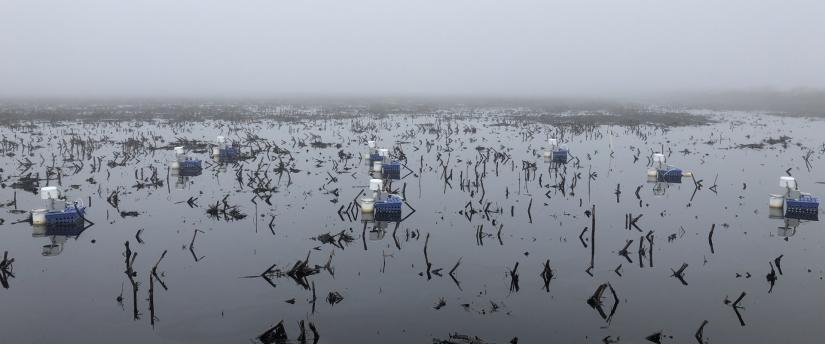
Delta Science Fellowship 2020
Fellow: Tyler Anthony, PhD Student, UC Berkeley
Research mentor: Whendee Silver, University of California, Berkeley
Community mentors: Steven Deverel, Hydrofocus, Inc
Why this research matters
California’s Sacramento-San Joaquin Delta was drained for agriculture over a hundred years ago, creating a mix of carbon-rich peatlands rich in organic matter and denser, clay-based soil. The cycling of nutrients through soil is vital for sustaining agricultural production, and understanding nutrient cycling is important to determine the pathways soil greenhouse gas emissions. This study aimed to better understand the carbon and nitrogen cycles in drained peatland soils, supporting adaptive agriculture management practices for a changing climate and to provide data to improve the potential land-based climate mitigation efforts across Delta land uses.
Project
This research project aims to increase understanding of how iron-rich peatland soils cycle carbon, nitrogen, and phosphorus in the delta and establish how carbon and nitrogen biogeochemistry and greenhouse gas emissions vary with management practices and crop type. It also explores how a drier future climate will influence biogeochemistry and greenhouse gas emissions in iron-rich soils and how to best adapt land management practices.
The goal of this research is to identify agricultural practices that can generate a portfolio of climate change adaptation and greenhouse gas mitigation strategies for delta farmers. The greenhouse gas data collected as part of this research also helped to generate increasingly accurate emission offset credits for potential wetland restoration projects in California’s Cap-and-Trade program.
Results
This project produced one of the most extensive measurements greenhouse gas fluxes from drained peatland soils. It collected more three years of continuous measurements of carbon dioxide (CO2), methane (CH4), and nitrous oxide (N2O) from three different agricultural land uses. Emissions had considerable year-to-year variability across sites, particularly with N2O. For example, on a cornfield with organic-rich soil, N2O fluxes represent up to 32% of the land use-related global warming potential. N2O emissions were largely driven by mineral nitrogen concentrations and winter flooding events. Short periods of production, 0.63% of measurements, increased yearly N2O emissions by 45.2%. The study also identified several soil mineral indices that impact carbon cycling in drained and reflooded wetland soils. Reactive iron was associated with lower carbon storage, while organic-associated aluminum increased carbon storage. Research is ongoing to understand how these minerals influence the production and consumption pathways of CH4 and N2O in these soils.
Management Applications
Reducing greenhouse gas emissions from the agricultural and land use sector is an important component of California’s climate change mitigation policy. By quantifying the occurrence and impact of hot spots and hot moments on net greenhouse gas emissions, this study provides important new data that could help land managers target wetland restoration and management strategies that minimize soil greenhouse gas emissions.
After publication data and results will be readily available for both policymakers and land managers (including the Department of Water Resources and Metropolitan Water District of Southern California), provided through partnerships with private industry (Hydrofocus Inc., Davis, CA), and published as open access datasets. Ongoing conversations between the Silver lab and policymakers will continue, so that scientific relevant data and results can influence carbon sequestration and climate change mitigation policy.
Select Publications and Presentations
Anthony, TL, Silver, WL, Juvenile fish nurseries in emergent tidal marshes of Suisun Marsh. Biennial Bay-Delta Science Conference, Sacramento CA, October 2018.
Anthony, T.L. and Silver, W.L. (2020), Mineralogical associations with soil carbon in managed wetland soils. Glob Change Biol. Accepted Author Manuscript. doi: 10.1111/gcb.15309
Anthony, TL, Silver, WL. (2020) Mineralogical associations with soil carbon in managed wetland soils. Global Change Biology. Under review.
Hemes, KS, Chamberlain SD, Eichelmann E, Anthony T, Valach A, Kasak K, Szutu D, Verfaillie J, Silver WL, Baldocchi DD (2019). Assessing the carbon and climate benefit of restoring degraded agricultural peat soils to managed wetlands. Agriculture and Forest Meteorology 268, 202–214
Chamberlain SD, Anthony T, Silver WL, Eichelmann E, Hemes KS, Oikawa PY, Sturtevant C, Szutu DJ, Verfaillie JG, Baldocchi DD (2018). Effect of soil iron content and sediment accretion on methane fluxes from wetlands restored on degraded peatlands in the Sacramento-San Joaquin Delta of California. Global Change Biology doi: 10.1111/gcb.14124
Attachments
 Tyler Anthony
Tyler Anthony
